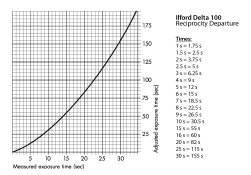So you are suggesting, I think: 1.The OP's findings are clearly and substantially wrong
2. Ilford has been incredibly lazy over reciprocity testing.
I have no idea how difficult such things are to ascertain but given that Ilford tries to meet customers' requirements to an extent that other manufacturers do not, it seems quite incredible that Ilford hasn't bothered to check on these matters when it is within individuals ability such as Howard Bond to ascertain reciprocity. Why not be as lazy with development times and simply cut and paste ID11 times for say HP5+ for all its films and all its developers? I don't think we are suggesting that Ilford has done this
Might it be that the methodology used was different?
Maybe Simon Galley will respond. I would if my company were accused of cutting and pasting our of laziness
pentaxuser
1. The OP did not make any "findings". He simply converted Ilford's graph into a table for easier and more accurate reference. I was simply pointing out that the data he was using, which he reasonably assumed to be accurate as it came from Ilford, was in fact questionable.
2. In Ilford's defence I note that the graph they publish does not claim to be measured reciprocity failure for Delta 100. It simply claims to be the adjustment one should make when making long exposures. Since the Ilford data suggests a longer exposure (by up to 2 stops) than was found to be necessary according to the measurements that Howard Bond and I made, and because Delta 100 is quite tolerant of over-exposure, exposing according to the Ilford graph would result in usable, although dense, negatives for scenes with a normal contrast range. (This would not necessarily be the case for scenes with a wide contrast range where one needs to place highlights and shadows accurately to retain detail in both, or for anyone needing to go beyond a metered exposure time of 30 seconds). But yes, I do still think it is lazy of them not to publish actual measured reciprocity data for their films.
3. As for Ilford's customer responsiveness - I agree and have complimented them on this in several posts. I use Ilford's products exclusively and would not have taken the time and trouble to make the measurements I have if I did not think they were the best products for my purposes. However that does not - and should not - prevent me from pointing out areas where I believe that the published data is potentially misleading and is not confirmed by measurements. Your analogy with film development times is spurious since they don't actually suggest the same development times for all their films and I would be equally suspicious if they did. Nevertheless for my own interest I also measured the characteristic curve of Delta 100 in ID-11 (see (there was a url link here which no longer exists)) and found the time for "normal" development at 20 deg. given in the Ilford data sheet to be correct.
4. I do not believe that the differences can be ascribed to testing methodology since it is extremely unlikely that any methodology would come up with identical figures for five films that have two different emulsion types (conventional and CCG) and three different ISO speeds (50, 100 and 400).
Andrew
 View attachment Ilford_Delta100_Reciprocity.pdf
View attachment Ilford_Delta100_Reciprocity.pdf View attachment Ilford_Delta100_Reciprocity.pdf
View attachment Ilford_Delta100_Reciprocity.pdf









